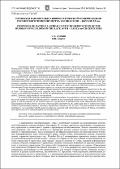| dc.contributor.author | Лугвин, С. Б. | |
| dc.coverage.spatial | Белгород | |
| dc.date.accessioned | 2017-04-11T07:40:52Z | |
| dc.date.available | 2017-04-11T07:40:52Z | |
| dc.date.issued | 2016 | |
| dc.identifier.citation | Лугвин, С. Б. Процессы рационально-бюрократической модернизации российского чиновничества в конце XVIII - начале XX вв. / С. Б. Лугвин // Научные ведомости Белгородского государственного университета. История. Политология. - 2016. - № 15(236), Вып. 39. - С. 172-177. | ru_RU |
| dc.identifier.uri | https://elib.gstu.by/handle/220612/15209 | |
| dc.description.abstract | Автор поставил перед собой цель рассмотреть процессы рационализации российской бюрократии в конце XYIII–начале XX вв. и показать их особенности в условиях сохранения в стране самодержавной монархии. В статье рассматриваются административные реформы, проведенные при Екатерине II, Александре I, Николае I и Николае II. В результате анализа административных преобразований сделан вывод, что к началу XX в. российское чиновничество приобрело целый ряд рационально-бюрократических черт, сближающих его с бюрократией западных стран: специализация управленческого труда, административная иерархия, правовая регламентация служебной деятельности, наличие бюрократического корпоративизма и др. Вместе с тем оно продолжало сохранять ряд патримониальных свойств: непотизм, клиентелизм, коррумпированность и пр. Данное обстоятельство, как подчеркивает автор,было связано с общей социально-экономической и культурной отсталостью России, незавершенностью процессов ее индустриализации и модернизации. | ru_RU |
| dc.description.abstract | The author set a goal to consider processes of rationalization of the Russian bureaucracy at the end
of 18-th – the beginning of the 20-th centuries and to show their features in the conditions of preservation in the country of an autocratic monarchy. In article the administrative reforms which are carried out at Catherine II, Alexander I, Nicholas I and Nicholas II are considered.
As a result of the analysis of administrative transformations the conclusion is drawn that by the beginning of the 20-th century the Russian officials gained a number of the rational and bureaucratic lines which are pulling together it with bureaucracy of the western countries: specialization of administrative work, administrative hierarchy, legal regulation of office activity, existence of bureaucratic corporativism, etc. At the same time it continued to keep a number of patrimonial properties: nepotism, kliyentelizm, corruption and so forth. This circumstance as the author emphasizes, was connected with the general social and economic and cultural backwardness of Russia, incompleteness of processes of its industrialization and modernization. | |
| dc.language.iso | ru | ru_RU |
| dc.publisher | НИУ "БелГУ" | ru_RU |
| dc.subject | История | ru_RU |
| dc.subject | Российская бюрократия | |
| dc.subject | Административные реформы | |
| dc.subject | Rrussian bureaucracy | |
| dc.subject | Administrative reforms | |
| dc.title | Процессы рационально-бюрократической модернизации российского чиновничества в конце XVIII - начале XX вв. | ru_RU |
| dc.title.alternative | Processes of Rational-Bureaucratic Modernization of the
Russian Officialdom in the Late 18-th – Early 20-th Centuries | |
| dc.type | Article | ru_RU |
| dc.identifier.udc | 321.1(45+57)"16/18" | ru_RU |
